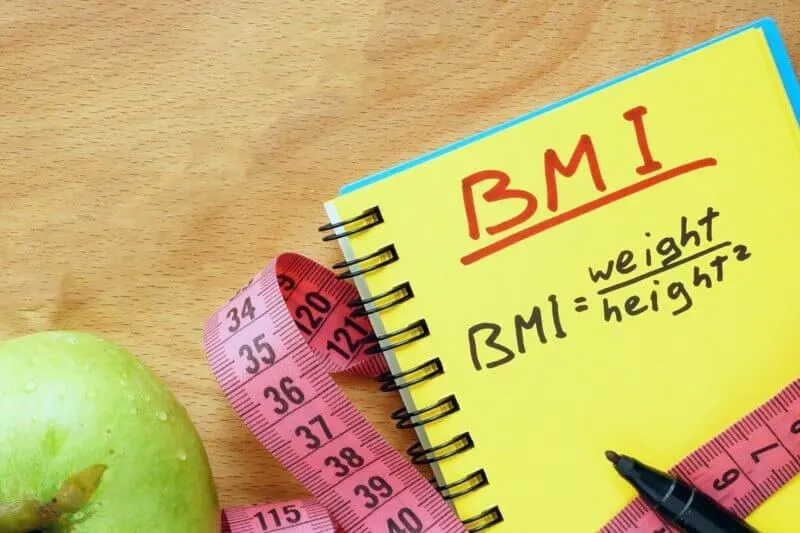What is body mass index?
You’ve no doubt heard of body mass index (BMI), but might be a little bit confused about what it is and what the results actually mean.
In very simple terms, body mass index looks at your weight relative to your height.
Use the calculator below to determine your BMI and then refer to the article below to put your results into context.
Other health calculators on this site
- Protein calculator for weight loss and building muscle
- Macronutrient percentage calculator
- Lean body mass calculator
- Total daily energy expenditure calculator
- Basal metabolic rate calculator
The higher your BMI, the greater your theoretical risk of developing obesity and associated metabolic disease like diabetes, high blood pressure, high blood lipids (fats), and cardiovascular disease (heart disease or stroke).
BMI classifications
Consider the following classification table, but be sure to keep reading in order to put these numbers into context.
| Classification | BMI(kg/m2 ) | Health Risk |
| Underweight | <18.5 | Low |
| Healthy range | 18.5-24.9 | Average |
| Overweight | 25.0-29.9 | Mildly increased |
| Obese | >30.0 | |
| Class I | 30.0-34.9 | Moderate |
| Class II | 35.0-39.9 | Severe |
| Class III | >40.0 | Very severe |
How accurate is body mass index for predicting health risk?
Body mass index is frequently criticised for not giving a well-rounded picture of health.
One of the main limitations of BMI is that it does not take body composition into account (i.e., how much fat and muscle you have).
If you have an athletic build (i.e., lots of muscle), it may indicate a “false positive” by overestimating your health risk where none actually exists.
Or you might be normal weight, but if you’re short in stature, then BMI would likely yield a higher number.
For example, you might be a shorter, well-muscled person with an elevated BMI of 27. Technically you’re “overweight” on the BMI scale, but your clinical values (cholesterol, blood sugar levels, blood pressure, etc) might still be normal.
So you CAN carry a little bit of body fat and still be healthy on the inside. In practice, I’ve seen plenty of people who were “overweight” or even “obese” by BMI standards but were regular exercisers who ate a healthy diet and were clinically very healthy.
On the other hand, I’ve also seen people who were relatively thin but carried a lot of localised belly fat. While their BMI values were technically “normal,” their clinical values were poor (i.e., hypertension, hyperlipidemia, type 2 diabetes, etc).
The case for body mass index
So is body mass index useless? No, not necessarily.
The real value for BMI is that, when put into context with other health biomarkers (i.e., blood glucose, insulin, blood pressure, lipids, waist circumference), it can help inform the overall clinical picture and provide a better understanding of your health.
From a public health or clinical research standpoint, BMI can be useful as a quick field measure for assessing health risk across large numbers of people with relatively minimal equipment (standard hospital scale and stadiometer for weight and height).
The big BMI picture
Playing the numbers game, it is true that, across a large population, people with a high body mass index do tend to have a greater health risk. But when you plop your elevated BMI on the bell-shaped curve, you might be the exception due to your height or muscle.
The big picture is that you shouldn’t hang your hat on any single clinical biomarker. Discuss your BMI with your doctor and be sure to put it into context relative to your overall medical history and clinical picture.
How to calculate body mass index
The formula for BMI is your body weight in kilograms divided by your height in meters squared (kg/m2). If you think in imperial units of measure, I’ll show you below how to convert units to metric.
Let’s do a sample calculation on a person who is 85 kg and 1.70 m tall.
Using this formula we get:
1) 85 / (1.70 x 1.70) – First, multiply the numbers in parentheses, so 1.65 x 1.65 = 2.72
2) 85 / (2.89) – Then divide your weight (85 kg) by 2.72 from above
3) = 29.41 kg/m2
Metric to imperial conversion
1 kg = 2.2 lbs
1 inch = 0.0254 m
To convert your body weight from lbs to kg, you divide pounds by 2.2 to get kg. So a body weight of 187 lbs divided by 2.2 = 85 kg.
To convert your height from inches to meters, take your height in inches and multiply by 0.0254. So a height of 67 inches x 0.0254 = 1.70 meters (as above)
BMI imperial formula
Metric conversions too much to handle? The US imperial formula for calculating BMI is [(lbs x 703)/ inches2] or, in plain English, that’s your weight in pounds multiplied by 703 and then that number divided by your height in inches multiplied by your height in inches (height squared).
- Multiply your weight in pounds by 703
- Multiply your height in inches by itself
- Then divide your answer in step 1 by what you got in step 2
If you have any questions about this calculator or BMI in general, feel free to leave your question below in the comments section.


Karen
Friday 13th of September 2019
I'd love to see FMI with categorisation:)
Dr Bill Sukala
Saturday 14th of September 2019
That's coming soon as part of a body composition calculator.